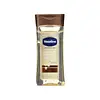What's inside
What's inside
 Key Ingredients
Key Ingredients

No key ingredients
 Benefits
Benefits

No benefits
 Concerns
Concerns

 Ingredients Side-by-side
Ingredients Side-by-side

Water
Skin ConditioningGlycerin
HumectantHydroxyethyl Urea
HumectantDimethicone
EmollientCocos Nucifera Oil
MaskingJojoba Esters
EmollientGluconolactone
Skin ConditioningPetrolatum
EmollientSteareth-21
CleansingCetyl Alcohol
EmollientDistearyldimonium Chloride
Aloe Barbadensis Leaf Juice
Skin ConditioningStearyl Alcohol
EmollientCyclopentasiloxane
EmollientCetearyl Alcohol
EmollientAmmonium Lactate
BufferingBehentrimonium Methosulfate
Glyceryl Stearate
EmollientMethyl Gluceth-20
HumectantButyrospermum Parkii Butter Extract
Skin ConditioningTheobroma Cacao Seed Butter
EmollientCeramide NP
Skin ConditioningPanthenol
Skin ConditioningCeramide Ns
Skin ConditioningCeramide Eos
Skin ConditioningMagnesium Ascorbyl Phosphate
AntioxidantTocopheryl Acetate
AntioxidantZingiber Officinale Root Extract
MaskingHydrolyzed Jojoba Esters
Skin ConditioningCeramide EOP
Skin ConditioningBisabolol
MaskingCaprooyl Phytosphingosine
Skin ConditioningEthylhexylglycerin
Skin ConditioningBehenic Acid
CleansingButylene Glycol
HumectantDimethiconol
EmollientCeramide AP
Skin ConditioningPropylene Glycol
HumectantStearamidopropyl Pg-Dimonium Chloride Phosphate
Polysorbate 60
EmulsifyingCeteareth-25
CleansingCaprooyl Sphingosine
Skin ConditioningCholesterol
EmollientEDTA
Methylparaben
PreservativeParfum
MaskingPotassium Hydroxide
BufferingCaramel
Cosmetic ColorantWater, Glycerin, Hydroxyethyl Urea, Dimethicone, Cocos Nucifera Oil, Jojoba Esters, Gluconolactone, Petrolatum, Steareth-21, Cetyl Alcohol, Distearyldimonium Chloride, Aloe Barbadensis Leaf Juice, Stearyl Alcohol, Cyclopentasiloxane, Cetearyl Alcohol, Ammonium Lactate, Behentrimonium Methosulfate, Glyceryl Stearate, Methyl Gluceth-20, Butyrospermum Parkii Butter Extract, Theobroma Cacao Seed Butter, Ceramide NP, Panthenol, Ceramide Ns, Ceramide Eos, Magnesium Ascorbyl Phosphate, Tocopheryl Acetate, Zingiber Officinale Root Extract, Hydrolyzed Jojoba Esters, Ceramide EOP, Bisabolol, Caprooyl Phytosphingosine, Ethylhexylglycerin, Behenic Acid, Butylene Glycol, Dimethiconol, Ceramide AP, Propylene Glycol, Stearamidopropyl Pg-Dimonium Chloride Phosphate, Polysorbate 60, Ceteareth-25, Caprooyl Sphingosine, Cholesterol, EDTA, Methylparaben, Parfum, Potassium Hydroxide, Caramel
 Reviews
Reviews

Ingredients Explained
These ingredients are found in both products.
Ingredients higher up in an ingredient list are typically present in a larger amount.
Parfum is a catch-all term for an ingredient or more that is used to give a scent to products.
Also called "fragrance", this ingredient can be a blend of hundreds of chemicals or plant oils. This means every product with "fragrance" or "parfum" in the ingredients list is a different mixture.
For instance, Habanolide is a proprietary trade name for a specific aroma chemical. When used as a fragrance ingredient in cosmetics, most aroma chemicals fall under the broad labeling category of “FRAGRANCE” or “PARFUM” according to EU and US regulations.
The term 'parfum' or 'fragrance' is not regulated in many countries. In many cases, it is up to the brand to define this term.
For instance, many brands choose to label themselves as "fragrance-free" because they are not using synthetic fragrances. However, their products may still contain ingredients such as essential oils that are considered a fragrance by INCI standards.
One example is Calendula flower extract. Calendula is an essential oil that still imparts a scent or 'fragrance'.
Depending on the blend, the ingredients in the mixture can cause allergies and sensitivities on the skin. Some ingredients that are known EU allergens include linalool and citronellol.
Parfum can also be used to mask or cover an unpleasant scent.
The bottom line is: not all fragrances/parfum/ingredients are created equally. If you are worried about fragrances, we recommend taking a closer look at an ingredient. And of course, we always recommend speaking with a professional.
Learn more about ParfumTheobroma Cacao Seed Butter comes from the Theobroma cacoa, or Cacao tree. Cacao trees are native to tropical landscapes.
Like other plant butters, Cacao seed butter is an emollient. Emollients help soothe and soften your skin. By creating a barrier to trap moisture in, emollients help keep your skin hydrated.
Cacao seed butter contains antioxidants known as polyphenols. Antioxidants help fight free-radical molecules by stabilizing them. Unstable free-radicals may cause damage to your skin cells. Antioxidants may help with anti-aging.
Theobroma Cacao Seed Butter can be bad for acne prone skin.
Learn more about Theobroma Cacao Seed Butter